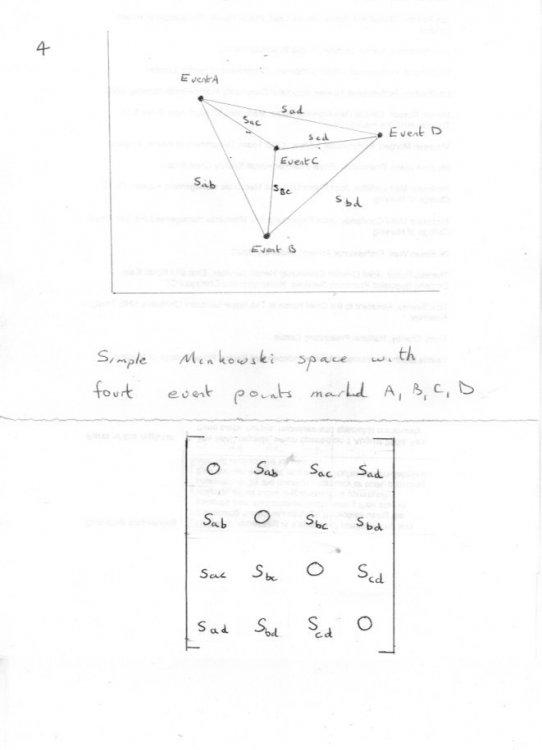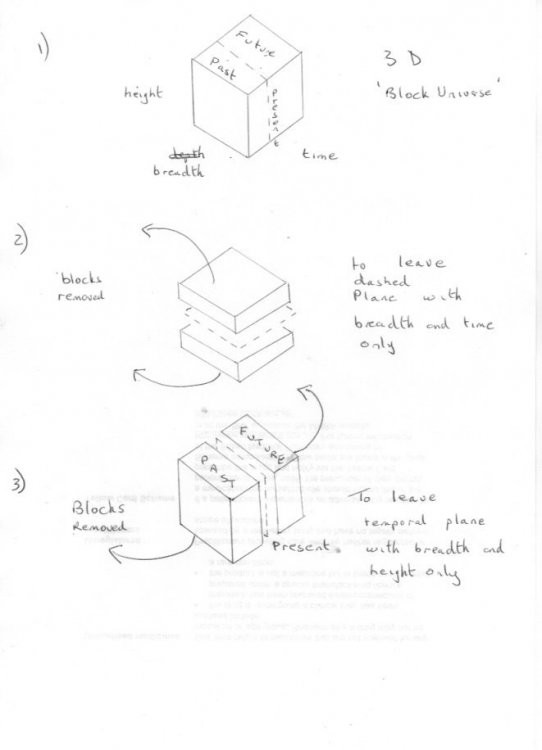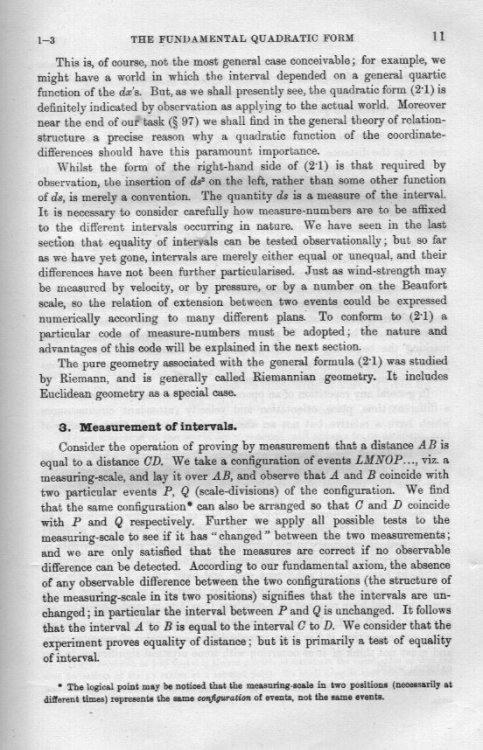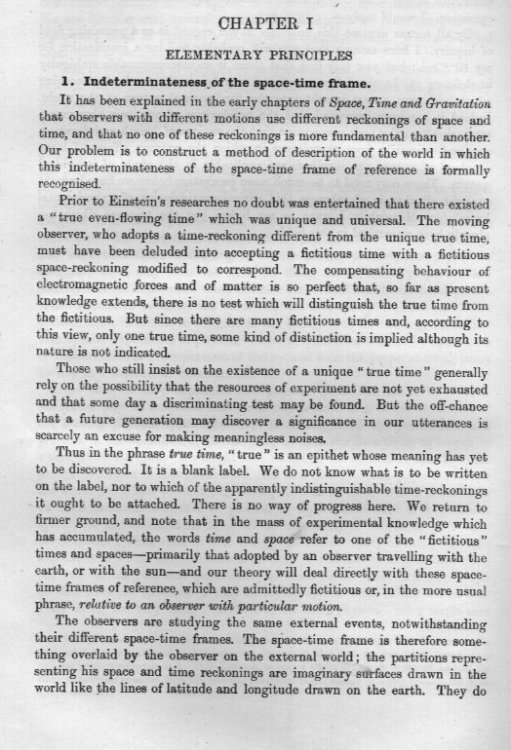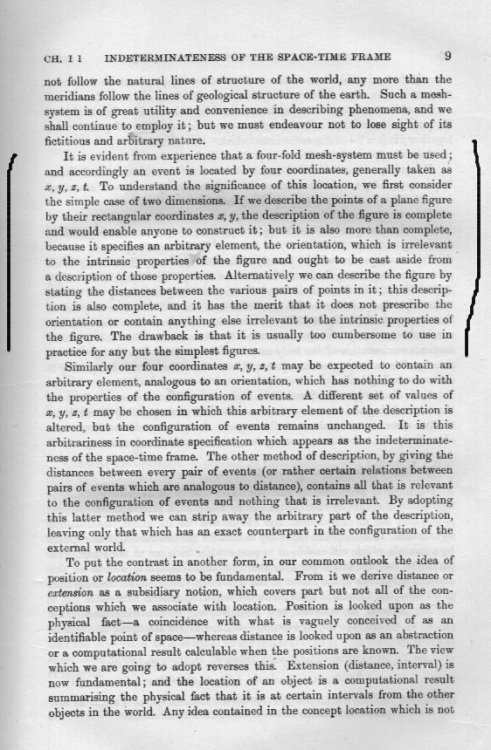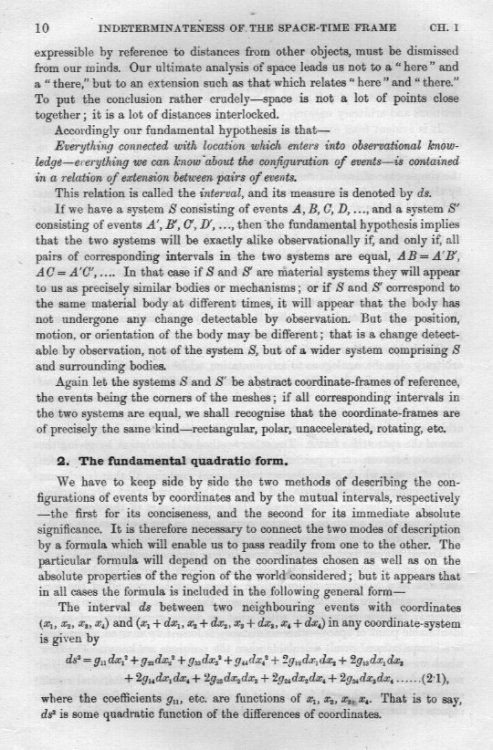Leaderboard
Popular Content
Showing content with the highest reputation on 08/02/20 in all areas
-
2 points
-
That provides a good start to my thoughts. The stated purpose of this thread is to examine the Physics of the question "What is Time ?" One way to do this is to go through the properties of time and see where that leads. Many entities are well describe by their properties in Physics. We could also ask questions like Is time a property of something ? Is time a coordinate in a coordinate system? If so, what if we do not have a coordinate system? What processes does time allow that cannot occur without time? Starting with coordinate systems. Sketch 1 shows a block universe, including time. I have only included 2 spactial dimensions (height and breadth) to be able to easily draw it. Since I have 2 spatial dimensions they permit areas so I can think about such concepts as pressure, magnetic flux density etc, and in conjunction with time processes such as magnetic induction. But there is a twist, depending upon how we regard the times, past present and future. In a block universe is 'time' Omar Khyam's moving finger that moves through the block universe as a temporal plane called the present ? If so it is like the focusing device of a scanner. Yet this temporal plane occupies zero duration (length) in time and its coordinate axes are purely spatial (height and breadth) So what happens if we are the past and future are inaccessible and throw them away ? We are left with plane that has no time. I have shown this idea in sketch 3 and a similar one operating on one of the spatial dimensions (height) in sketch 2. What else do we do with coordinate systems ? Well we look for invariants so we can transform them. So how about the ultimate transformation, doing away with the coordinate system alltogether ? In Minkowski space the invariant is the interval, symbol S, treating each axes as equivalent, but using Markus sign system. Each point in a Minkowski space is called an event and I have picked 4 of them and labelled them A, B C and D. Again for ease of drawing I have reduced the space this time to one temporal and one spatial axis. Sketch4 shows the result. Each event has an invariant interval to every other event in the space. The network formed by all these invariants will be the same in all coordinate systems, by definition. So we can throw away the coordinate system - We don't need it, all the information is contained in the table of S values, presented conveniently in matrix format at the bottom. So do we need an axis called time?2 points
-
Time/CPT symmetry is at heart of many models of physics, like unitary evolution in quantum mechanics, or Lagrangian formalism we use from classical mechanics, electromagnetism, up to general relativity and quantum field theories. In theory we should be able to decompose any scenario (history of the Universe?) into ensemble of Feynman diagrams, apply CPT symmetry to all of them, getting CPT analogue of entire scenario (?) There are many QM-based experiments which kind of use time symmetry (?), for example (slides with links) : Wheeler experiment, delayed choice quantum eraser (DCQE), “asking photons where they have been”, “photonic quantum routers”, Shor algorithm as more sophisticated DCQE. However, this symmetry is quite nonintuitive, very difficult to really accept – mainly due to irreversibly, thermodynamical counterarguments (are there other reasons?) Can e.g. this conflict with 2nd law of thermodynamics be resolved by just saying that symmetry of fundamental theories can be broken on the level of solution, like throwing a rock into symmetric lake surface? Are all processes reversible? (e.g. wavefunction collapse, measurement) So is our world time/CPT symmetric? What does it mean? Personally I interpret it that we live in 4D spacetime, (Einstein's) block universe/eternalism: only travel through some solution (history of the universe) already found in time/CPT symmetric way, like the least action principle or Feynman path/diagram ensemble - is it the proper way to understand this symmetry? Are there other ways to interpret it?1 point
-
We've never actually discussed it as staff before, but I know that the science is the only thing that matters here. Even if a member was told NOT to bring up a subject again, if they did so anyway BUT THEY IMMEDIATELY SHOWED SUPPORTIVE EVIDENCE for their arguments, nobody on staff would insist the thread be closed on principle. Instead, we'd actually have some science to discuss meaningfully, evidence to weigh, reasoning to do. PrimalMinister, I think you're experiencing why a thorough study of science, including the underlying mathematics principles, is needed in order to form working hypotheses. You write like you think philosophy is science-lite, without the maths, but you actually have to study philosophy too in order to apply it. It's clear you've not understood much of physics, and therefore think it's wrong instead of difficult. You've started making up explanations based on limited study, filling in the gaps with guesswork that seems absolutely perfect, but only to you. You aren't doing science, and I think you're actually hampering your own ability to learn. Try leading with the evidence next time, and the members here will be able to better discuss your ideas with you.1 point
-
They do annihilate. Particle/antiparticle pairs can form bound states before doing so. Electrons and positrons form positronium, only annihilating after they’s dropped into the ground state. The article says this particle could be a loosely bound pair of mesons. The J/psi (charm/anticharm), which is what it decays into, has a lifetime less than 10^-20 seconds1 point
-
+1. Very interesting, meaningful and inspiring conversation going on here. I only wish to emphasize observation by @Duda Jarek that charge symmetry can indeed be formulated either locally or globally.1 point
-
There is no entropy in this fundamental level like QFT (it is zero). For entropy we need to get to effective picture, like replacing positions of particles with densities - what is kind of mean field approximation. Fundamental symmetries can be violated on the level of solution, like throwing a rock to symmetric lake surface. Assuming there is a (time/CPT symmetric) tendency for entropy growth, low entropic Big Bang should cause 2nd law of thermodynamics. We know that Big Bang had low entropy, need to understand why - a natural explanation is that because everything was localized(?)1 point
-
Eddington wrote two books in the subject, both from Cambridge Univesity Press. Both are excellent reading. Eddington was a thoughtful man and he shares his thoughts and reasoning. There were several editions (and revisions) of both books Get the latest you can. Mine were 1966 for the first and 1954 for the second (mathematical) one. First was a smaller more populist volume Space, Time and Gravitation An outline of the General Theory of Relativity. Second was a full blooded mathematical volume The Mathematical Theory of Relativity. It is interesting that Einstein published several populist books but kept his mathematics for papers. I have attached four pages from Eddington's Mathematical Theory. The place where he introduces the locked interval (your relationships) idea is marked on book page 101 point
-
That’s because there isn’t any such ‘problem’. How could there be? The energy-momentum tensor is a local quantity, whereas the self-interaction of the gravitational field is non-local, so of course it doesn’t form part of aforementioned tensor. It can never be a tensorial quantity, because all tensors are local, and any concept of ‘gravitational energy’ is necessarily non-local and observer-dependent. You can, however, define such a quantity as a pseudo-tensor (such as the Landau-Lifshitz pseudo-tensor, or the Einstein pseudo-tensor); this allows you to write down a combined conservation law. The self-interaction of the field is instead encoded in the structure of the field equations themselves; that is why they are non-linear. This is perfectly well understood, both physically and mathematically, so there is no ‘problem’ here.1 point
-
If we can create nuclear bombs 1000x hiroshima, wouldn't it be fairly simple to use it to power space ships which could accelerate to the point where a trip to the outer planets would take days rather than years? Is it true that this is already quite possible, but governments won't let us do it because of the potential dangers of nuclear accident? Cheerz GIAN xx1 point
-
1 point
-
The angular size is about the same, which is why we get solar eclipses. The sun is ~400x bigger but also ~400x further away.1 point
-
The star TYC 8998-760-1 (top center) was photographed with two giant exoplanets (arrows), the first time astronomers have directly imaged more than one planet orbiting a sunlike star. The bright spots above star TYC 8998-760-1 are other stars in the background. BOHN ET AL/ESO https://www.sciencenews.org/article/first-picture-sun-like-star-multiple-exoplanets-astronomy-planets1 point




